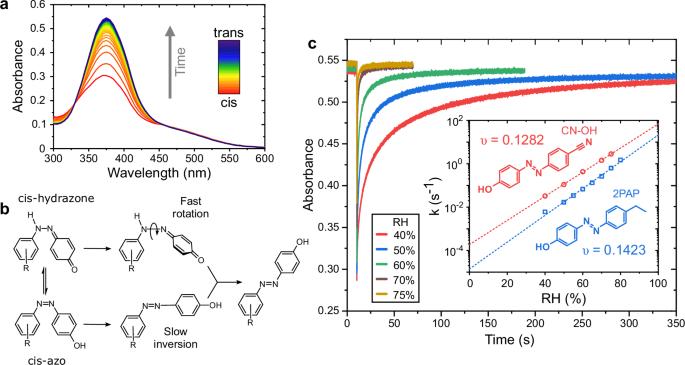Strategies to control humidity sensitivity of azobenzene isomerisation kinetics in polymer thin films
IF 7.5
Q1 MATERIALS SCIENCE, MULTIDISCIPLINARY
引用次数: 0
Abstract
Azobenzenes are versatile photoswitches that garner interest in applications ranging from photobiology to energy storage. Despite their great potential, transforming azobenzene-based discoveries and proof-of-concept demonstrations from the lab to the market is highly challenging. Herein we give an overview of a journey that started from a discovery of hydroxyazobenzene’s humidity sensitive isomerisation kinetics, developed into commercialization efforts of azobenzene-containing thin film sensors for optical monitoring of the relative humidity of air, and arrives to the present work aiming for better design of such sensors by understanding the different factors affecting the humidity sensitivity. Our concept is based on thermal isomerisation kinetics of tautomerizable azobenzenes in polymer matrices which, using pre-defined calibration curves, can be converted to relative humidity at known temperature. We present a small library of tautomerizable azobenzenes exhibiting humidity sensitive isomerisation kinetics in hygroscopic polymer films. We also investigate how water absorption properties of the polymer used, and the isomerisation kinetics are linked and how the azobenzene content in the thin film affects both properties. Based on our findings we propose simple strategies for further development of azobenzene-based optical humidity sensors. Many variables related to azobenzene-based humidity sensors remain. Here, a small library of tautomerisable azobenzenes is studied for their humidity dependent thermal isomerisation rate in polymer thin films.

聚合物薄膜中偶氮苯异构化动力学的湿度敏感性控制策略。
偶氮苯是一种多功能光开关,在光生物学和能量存储等领域的应用都引起了人们的兴趣。尽管偶氮苯具有巨大潜力,但将基于偶氮苯的发现和概念验证从实验室转化到市场却极具挑战性。在此,我们将概述从发现羟基偶氮苯对湿度敏感的异构化动力学,到用于空气相对湿度光学监测的含偶氮苯薄膜传感器的商业化努力,再到目前的工作,旨在通过了解影响湿度敏感性的不同因素来更好地设计此类传感器。我们的概念基于聚合物基质中可同分异构的偶氮苯的热异构化动力学,利用预定义的校准曲线,可将其转换为已知温度下的相对湿度。我们展示了一个小型的可进行同素异构的偶氮苯库,这些偶氮苯在吸湿性聚合物薄膜中表现出湿度敏感的异构化动力学。我们还研究了所用聚合物的吸水性能与异构化动力学之间的联系,以及薄膜中的偶氮苯含量如何影响这两种性能。根据我们的研究结果,我们提出了进一步开发基于偶氮苯的光学湿度传感器的简单策略。
本文章由计算机程序翻译,如有差异,请以英文原文为准。
求助全文
约1分钟内获得全文
求助全文
来源期刊

Communications Materials
MATERIALS SCIENCE, MULTIDISCIPLINARY-
CiteScore
12.10
自引率
1.30%
发文量
85
审稿时长
17 weeks
期刊介绍:
Communications Materials, a selective open access journal within Nature Portfolio, is dedicated to publishing top-tier research, reviews, and commentary across all facets of materials science. The journal showcases significant advancements in specialized research areas, encompassing both fundamental and applied studies. Serving as an open access option for materials sciences, Communications Materials applies less stringent criteria for impact and significance compared to Nature-branded journals, including Nature Communications.
 求助内容:
求助内容: 应助结果提醒方式:
应助结果提醒方式:


